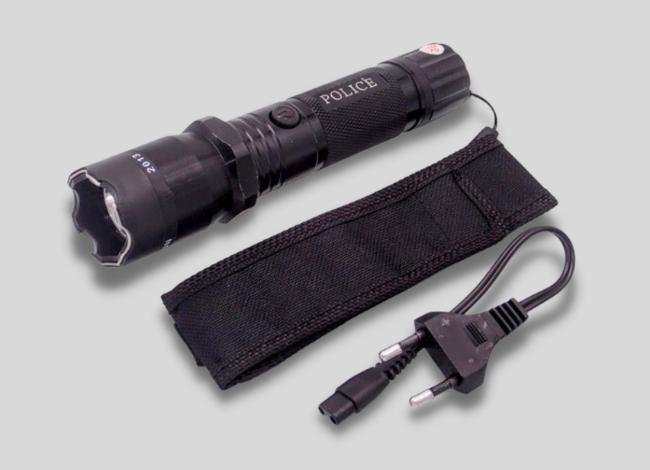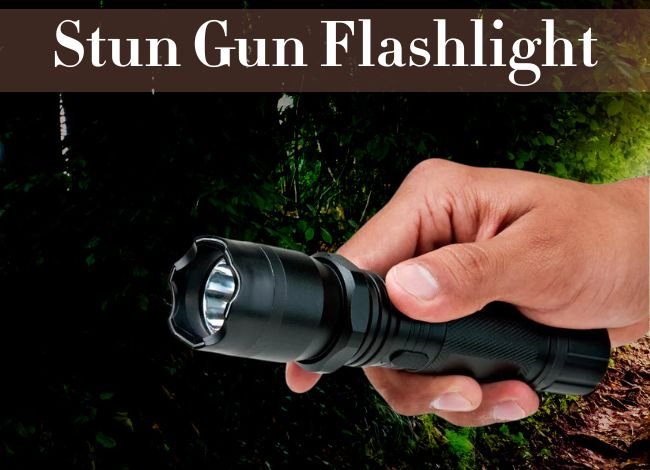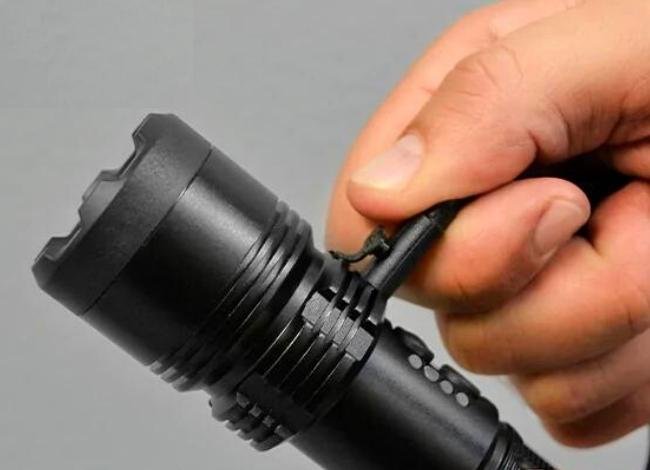Last Updated on May 8, 2025
A stun gun flashlight is an innovative tool designed for both illumination and self-defense. It combines the power of a high-lumen flashlight with a non-lethal electroshock mechanism, making it an ideal device for personal protection. But despite its popularity, many users still ask: how to charge a stun gun flashlight properly?
Understanding the correct charging procedure is crucial—not only to keep your device functional but also to ensure your safety and the longevity of the unit. In this detailed guide, we’ll walk you through the process of charging, offer tips for long-term battery care, explore compatible charging devices, and explain key safety and legal considerations.
Understanding the Internal Battery System
Before charging, it’s important to know what kind of battery your stun gun flashlight uses. Most models include one of the following:
Ni-MH Battery (Nickel-Metal Hydride)
- Rechargeable
- More environmentally friendly than older batteries
- Often used in mid-range stun gun flashlights
- Requires full discharge before recharging for optimal longevity
Li-ion Battery (Lithium-ion)
- Lightweight and efficient
- Found in higher-end models
- Faster charging with longer battery life
- More sensitive to overcharging, requiring protective charging circuits
Identifying your battery type helps ensure you follow the correct charging and maintenance practices.
Which Charging Device Is Best?
When it comes to how to charge a stun gun flashlight, using the right charger matters:
1. Factory-Supplied Charger
- Always the best choice
- Designed specifically for voltage and current needs
2. Universal USB Chargers
- Suitable for models with USB compatibility
- Should output 5V/2A or match your product specs
3. AFR 110V–220V Wall Adapter
- Designed for a wide range of stun gun flashlights
- Offers safe and stable charging

4. Snipertek 120V Charger
- Ideal for U.S. outlets
- Works with most compact flashlights
Avoid using phone chargers or low-quality adapters, as they may underpower or overheat the device.
Step-by-Step Instructions on How to Charge a Stun Gun Flashlight
Charging the device safely involves a few clear steps:
Step 1: Power Off the Flashlight
Never charge the device while it’s in use or turned on—it may cause overheating or electrical issues.
Step 2: Find the Charging Port
Some flashlights have a hidden port under a rubber cover, while others come with built-in plugs.
Step 3: Insert the Adapter
Use the factory-supplied or compatible charging cable and securely connect it.
Step 4: Connect to Power Source
Plug into a 110V–220V wall outlet or USB source. If using USB, ensure the current is steady and sufficient.
Step 5: Observe Charging Indicators
Most devices have LED lights that show status:
- Red = Charging
- Green = Fully charged
Step 6: Unplug When Charged
After 6–8 hours, unplug the device to avoid overcharging and battery wear.
Charging Frequency and Battery Maintenance
To extend your battery’s life:
- 🔄 Charge every 30 days even if unused
- 🔋 Avoid complete discharges in Li-ion models
- 🔌 Do not leave charging overnight
- 🌡️ Keep away from extreme temperatures
Regular maintenance not only ensures the flashlight works when needed but also helps retain battery efficiency over time.
How Long Should You Charge It?
On average:
- Initial Charge: 8 hours (first-time use)
- Regular Charge: 6–8 hours
- Warning: Over 10 hours can damage the internal battery
If your flashlight takes significantly longer or the LED doesn’t indicate charging, the battery or charger may be faulty.
Featured Charging Accessories
AFR 20cm Charging Cable Review
AFR offers dependable charging solutions. Their 110V–220V cable fits most stun gun flashlight models and is UL-certified.
Key Features:
- Durable insulation
- Compact design
- Surge-protected
- 6-month warranty
Snipertek 120V Charger Review
Snipertek’s 12-inch charging cable is ideal for U.S. households.
Features at a glance:
- 120V plug-in
- Reinforced build
- Simple plug-and-charge mechanism
Where and Why to Use a Stun Gun Flashlight
Personal Safety and Self-Defense
The stun feature is highly effective in disabling attackers by delivering a high-voltage shock that disrupts muscle control without causing permanent harm.
Utility and Night Visibility
Its flashlight function makes it useful during:
- Night walks
- Car breakdowns
- Outdoor travel
Real-World Usage Scenarios
- Walking Alone at Night
A stun gun flashlight offers both visibility and protection. - Keeping in Your Car
Useful during emergencies like flat tires or suspicious activity near your vehicle. - Urban or Rural Security
Ideal for delivery drivers, taxi drivers, or anyone traveling through isolated areas.
Safety First: Is It Dangerous?
While a stun gun flashlight is not lethal, misuse can cause serious injury. Risks include:
- Muscle spasm or falls due to shock
- Panic reactions
- Burns in rare cases
Always use with caution and never on vulnerable individuals (elderly, children, or heart patients).
Legal Aspects to Consider
Before purchasing or using:
- Check Local Laws: Not all U.S. states allow stun gun possession.
- Restricted Areas: Airports, government buildings, and schools may prohibit them.
- Permit May Be Needed: Some jurisdictions require a concealed weapon license.
Always comply with local regulations to avoid fines or confiscation.
Safe Storage and Transportation
- 🧰 Use a Carrying Case: Protects against accidental discharge
- 🔐 Lock It Away from Children
- ❄️ Avoid Damp Areas: Moisture can short-circuit internal components
- ☀️ Store in a Cool, Dry Place
Common Mistakes While Charging
- Using wrong voltage
- Charging while turned on
- Ignoring battery overheating
- Leaving plugged in too long
These can lead to decreased battery performance or even device failure.
Do’s and Don’ts Recap
✅ Do’s
- Follow the manual
- Use recommended charger
- Test monthly
- Keep away from water
- Check legal status
❌ Don’ts
- Don’t let children handle it
- Don’t use on flammables
- Don’t modify wiring
- Don’t submerge in water
- Don’t carry into restricted zones
Additional FAQs
Q1: Can I use a power bank to charge the stun gun flashlight?
Yes, if the power bank provides the correct output (5V, 2A). Check your manual before doing so.
Q2: Can I use a laptop USB port for charging?
Technically yes, but laptop USB ports provide lower current. It may charge slower or not at all for larger batteries.
Q3: How do I know when my stun gun flashlight needs a new battery?
If the battery doesn’t hold a charge or the light/stun output weakens, it’s likely time for a replacement—if supported.
Q4: Is it safe to charge it in a moving vehicle?
Yes, if the device has car-compatible USB charging and you’re using a voltage-stable car charger.
Q5: What happens if the charger gets hot during use?
Unplug it immediately. Overheating chargers are often signs of faulty or incompatible accessories.
Final Thoughts: Keep It Charged, Keep It Safe
Mastering how to charge a stun gun flashlight isn’t just about plugging it in—it’s about understanding battery types, safe charging practices, and maintaining your device for reliable use.
Whether you’re using it for security, emergencies, or outdoor activities, a fully charged, well-maintained stun gun flashlight could make all the difference when it matters most. Follow the best practices outlined above and always use your device responsibly.

I bought 3 of the 1188 Type Self-Defence Flashlights and all 3 of them can’t get to the green light when charging. Any suggestions would be appreciated
Hi there — if all three of your 1188 Type self-defense flashlights never reach the green light while charging, it usually points to an issue with either the batteries or the charger. Here are a few things to try:
1. Check the battery contacts
Make sure the battery and the internal contacts are clean and not corroded. Wipe gently with a dry cloth.
2. Try a different wall outlet or USB adapter
Sometimes the charger isn’t getting enough power.
3. Test with a different charger (if you have one)
If none of the units turn green, the included charger may be faulty.
4. Check the batteries
If the flashlights are older or the batteries were stored fully drained, they may not hold a charge anymore. Swapping in a fresh 18650 battery often fixes the issue.
5. Indicator light may be faulty
Occasionally the flashlight may be charging, but the LED indicator doesn’t switch to green.
If all three units behave the same way, the charger is the most likely problem. Trying a known-good charger or a new battery is usually the quickest way to confirm it.